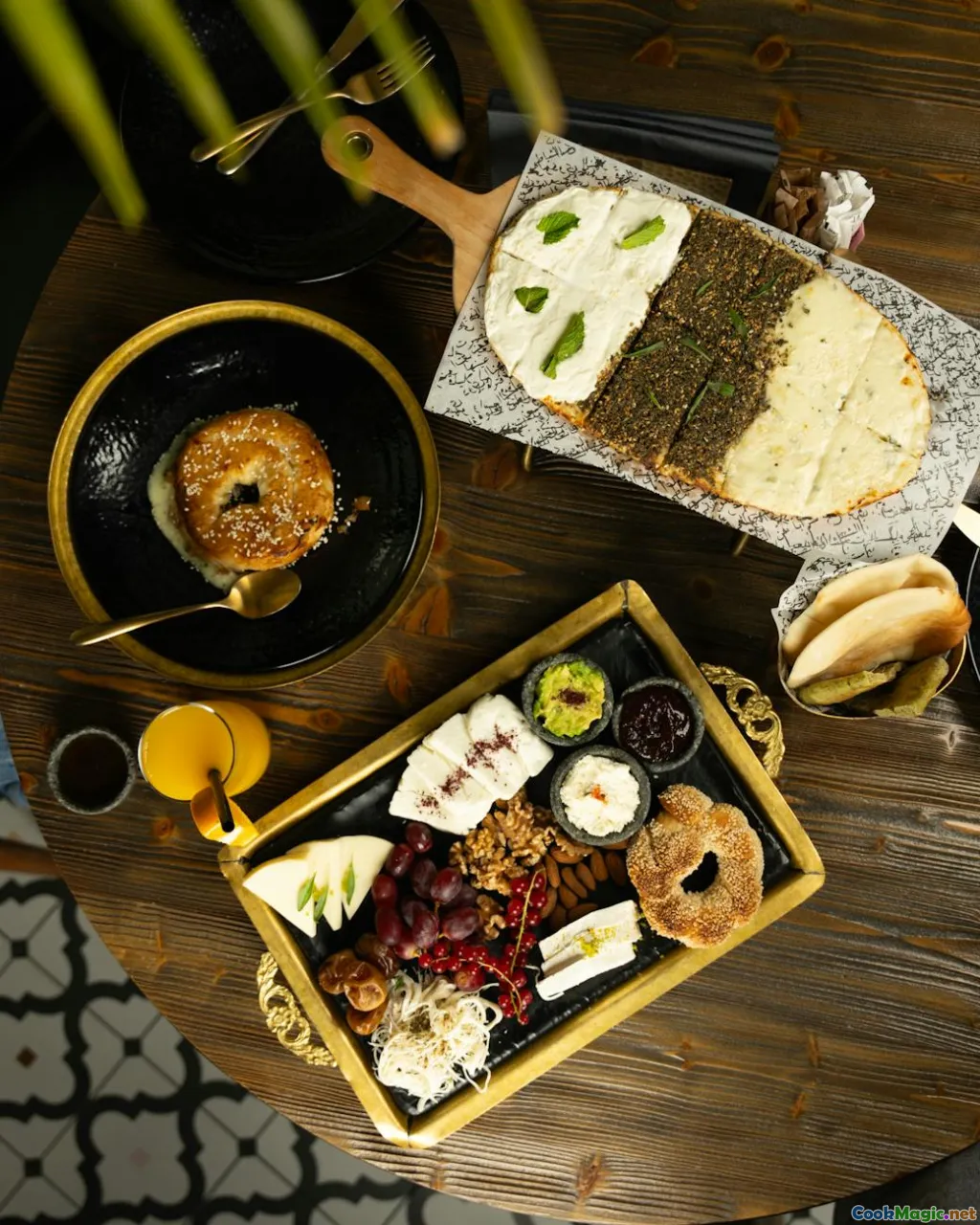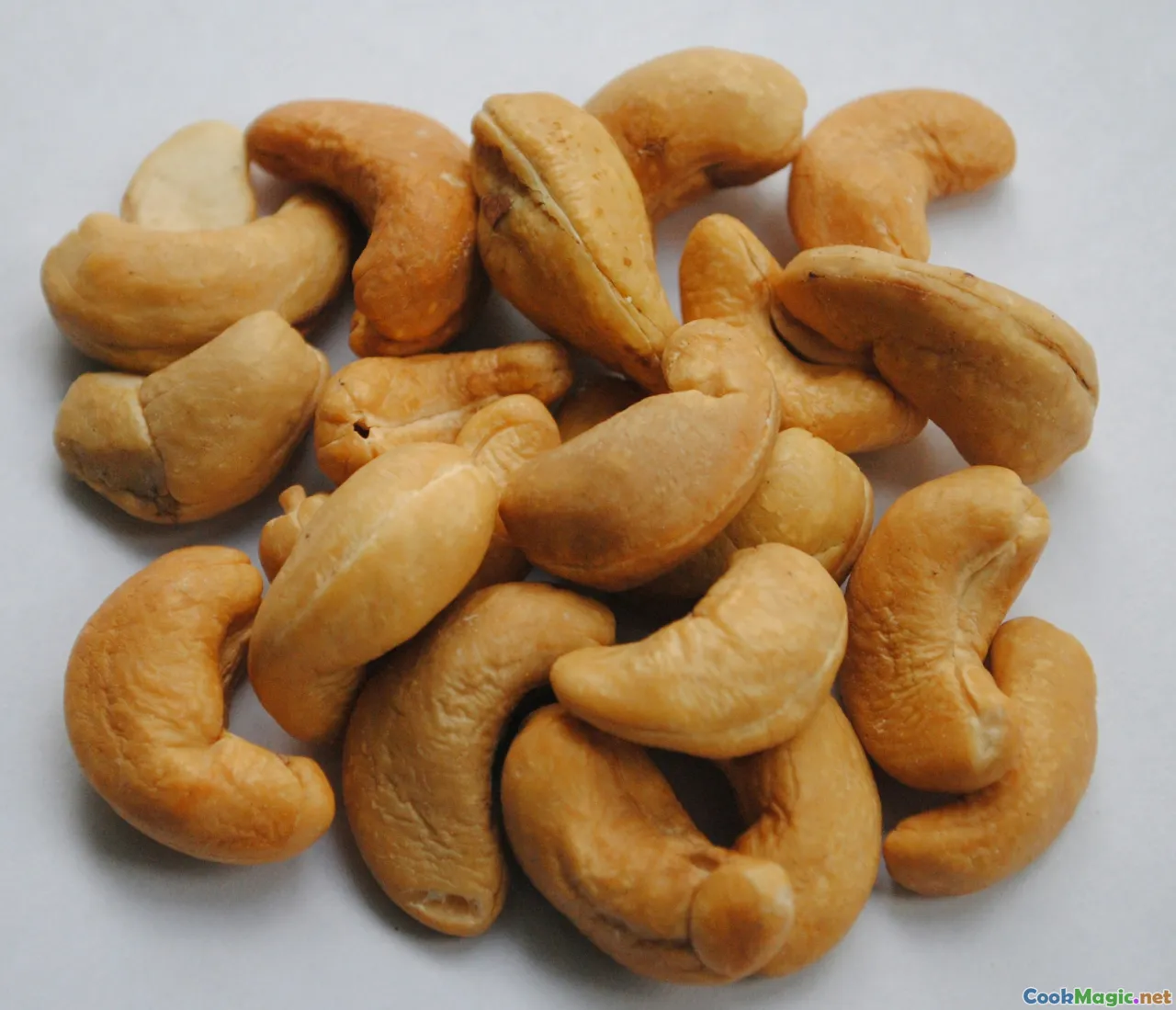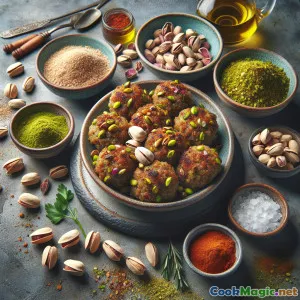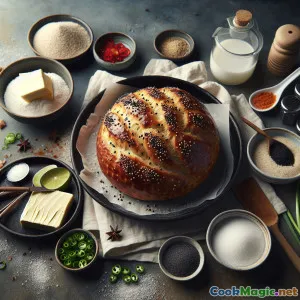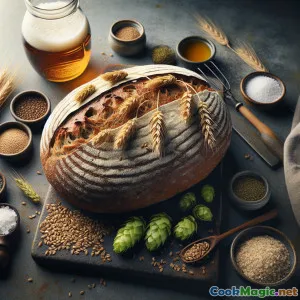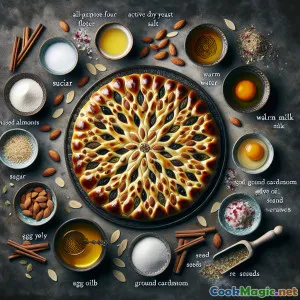
Pide alle Mandorle Regale Ispirata allo Splendore Ottomano
(Regal Almond Pide Inspired by Ottoman Splendor)
(0 Recensioni)0
3,000
agosto 14, 2025
Segnala un problema
Ingredienti
-
300 grams Farina 00
(Unbleached recommended)
-
7 grams Lievito secco attivo
(1 pacchetto)
-
120 ml Latte caldo
(Around 40°C (105°F))
-
60 ml Acqua tiepida
-
2 tbsp Zucchero
(Superfine recommended)
-
3 tbsp Olio d'oliva
-
1 tsp Sale
(Sea salt flakes preferred)
-
100 grams Mandorle sbianchite
(Ammontare grossolanamente)
-
3 tbsp Miele
(Quality floral varieties are best)
-
0.5 tsp Cardamomo macinato
(Aggiunge spezie riscaldanti)
-
1 whole Tuorlo d'Uovo
(per spennellare)
-
1 tbsp Semi di sesamo
-
1 tbsp Petali di rosa
(Edible, dried, for garnish)
(Unbleached recommended)
(1 pacchetto)
(Around 40°C (105°F))
(Superfine recommended)
(Sea salt flakes preferred)
(Ammontare grossolanamente)
(Quality floral varieties are best)
(Aggiunge spezie riscaldanti)
(per spennellare)
(Edible, dried, for garnish)
Nutrizione
- Porzioni: 4
- Dimensione Porzione: 1 oval pide (about 150g)
- Calories: 490 kcal
- Carbohydrates: 68 g
- Protein: 12 g
- Fat: 18 g
- Fiber: 4 g
- Sugar: 15 g
- Sodium: 430 mg
- Cholesterol: 24 mg
- Calcium: 80 mg
- Iron: 2.1 mg
Istruzioni
-
1 - Activate Yeast:
Combine warm milk, water, sugar, and yeast in a small bowl. Let sit for 10 minutes until frothy.
-
2 - Prepare Dough:
In a mixing bowl, add flour and salt. Pour in yeast mixture and 2 tbsp olive oil. Mix to form a sticky dough.
-
3 - Knead Dough:
Turn the dough onto a floured surface and knead until smooth and elastic. Drizzle remaining olive oil over dough and coat.
-
4 - First Rise:
Place dough in an oiled bowl, cover, and let rise in a warm place for 30–40 minutes, until doubled.
-
5 - Prepare Almond Topping:
Mix chopped almonds with honey and (optional) cardamom.
-
6 - Shape Pides:
Punch down the risen dough. Divide into 4 pieces. Shape each into an oval. Pinch and twist ends for classic pide shape.
-
7 - Assembly:
Transfer ovals onto parchment-lined baking sheets. Make a shallow indent down the center with your knuckles. Spoon almond-honey mixture along indent.
-
8 - Final Proof:
Brush dough edges with egg yolk, sprinkle sesame seeds (if using), and cover loosely. Let stand for 10 minutes.
-
9 - Bake:
Bake in a preheated oven at 200°C (390°F) for 18–20 minutes or until golden, crisp, and fragrant.
-
10 - Garnish & Serve:
Cool slightly, then garnish with a drizzle of honey and rose petals. Best served warm.
Combine warm milk, water, sugar, and yeast in a small bowl. Let sit for 10 minutes until frothy.
In a mixing bowl, add flour and salt. Pour in yeast mixture and 2 tbsp olive oil. Mix to form a sticky dough.
Turn the dough onto a floured surface and knead until smooth and elastic. Drizzle remaining olive oil over dough and coat.
Place dough in an oiled bowl, cover, and let rise in a warm place for 30–40 minutes, until doubled.
Mix chopped almonds with honey and (optional) cardamom.
Punch down the risen dough. Divide into 4 pieces. Shape each into an oval. Pinch and twist ends for classic pide shape.
Transfer ovals onto parchment-lined baking sheets. Make a shallow indent down the center with your knuckles. Spoon almond-honey mixture along indent.
Brush dough edges with egg yolk, sprinkle sesame seeds (if using), and cover loosely. Let stand for 10 minutes.
Bake in a preheated oven at 200°C (390°F) for 18–20 minutes or until golden, crisp, and fragrant.
Cool slightly, then garnish with a drizzle of honey and rose petals. Best served warm.
Ulteriori informazioni su: Pide alle Mandorle Regale Ispirata allo Splendore Ottomano
Topkapi Palace Almond Pide: History, Divinity, and a Modern Twist
The heart of Turkish cuisine is storied, lavish, and tumultuous, yet always tied to nourishment and celebration. Bread, the quintessential symbol of sustenance, echoes through its culture; but few delights have the regal pedigree of pide—particularly this unique iteration inspired by Topkapi Palace’s grandeur, marrying soft bread with jewel-like almonds, flower honey, and summer’s golden sesame.
The Topkapi Palace, a former seat of Ottoman sultans in Istanbul, is itself a beacon of culinary innovation and splendor. The palace tables would glitter with nut-studded treats, seed-sprinkled confections, and honeyed breads introduced from ancient Anatolian villages to aristocratic courts. The modern Almond Pide, a respectful debutante to this lineage, incorporates blanched almonds, a signifier of abundance and wealth (especially within Ottoman gastronomy). Almonds were prized not just for their taste, but their medicinal value—a key promise in palace kitchens, overseen by court physicians and elite pastry-makers ('helvahane').
Honey, too, was revered: it drips decadence, hints at the fertility of Anatolia, and carries floral overtones coveted by centuries of culinary poets. Rose petals crown this recipe, recalling sultan’s celebrations where each episodic feast—sometimes hours long—concluded with sweet breads fragrant with essence of rose, cardamom, or saffron.
Why Bake This Pide?
Uniqueness: The use of almond in bread is not a standard confection in Turkey—instead, this draws upon the inspiration of palace riches, accessible to those beyond the court. Where cheese or minced meats reign in classic pide, Topkapi Palace Almond Pide forges new ground as a luxurious bread that straddles dessert and festive table centerpiece.
Tips & Notes:
- The richness of blanched almonds is best brought forward by a generous covering of honey—they create a pleasing crunch that gently melts into the bread’s crumb. You may substitute almonds with pistachios for a different accent.
- Cardamom and rose petals boost the experience but may muddle pure almond and honey aromas; use in moderation.
- Brushing the edges with egg yolk grants both shine and deeper flavor.
Perfect Pairings: Slice and accompany with softly whipped kaymak (Turkish clotted cream), a fragrant cup of black tea, or, for a savory-sweet event, alongside crumbly ewe’s cheese. The pides also freeze beautifully—reheat briefly before serving and reapply honey for gloss and aroma.
Cultural significance: Bread, in the Turkish tradition, must never be wasted. Indeed, this recipe provides an ode to sharing, as was customary in courtly feasts. It can easily take center stage during Ramadan, Eid, or celebratory brunch tables, bridging sweet-and-savory divides with Ottoman ingenuity.
Origins & Perspective
The almond and honey pairing isn’t unique to Turkey, but when layered with leavened pide, history feels a little closer—each golden loaf a nod to harvests, palatial excess, conquest, and co-existence. Even the rose here is not only for garnish—Ottoman confectionaries worked precious attar into jellies and relishes, and rosewater glazed many sweets destined for the sultan’s private table.
There’s history you taste: the warmth in every bite recollects not just ingredients, but the land, climate, and grand kitchens pushing Turkish cuisine beyond borders centuries ago. For the modern cook, Topkapi Palace Almond Pide brings sensory delight, historical narrative, and an opportunity to celebrate an often-overlooked part of Anatolia’s rich baking traditions.
Summary: This regal almond pide, soft in crumb and luxuriously encrusted in almonds and honey, bridges past and present. Warm, sharing-ready, and redolent with history—it’s bread that celebrates both everyday happiness and exceptional gatherings.

